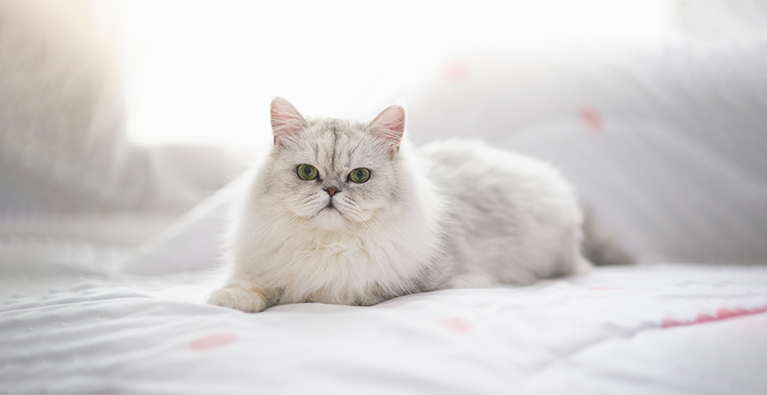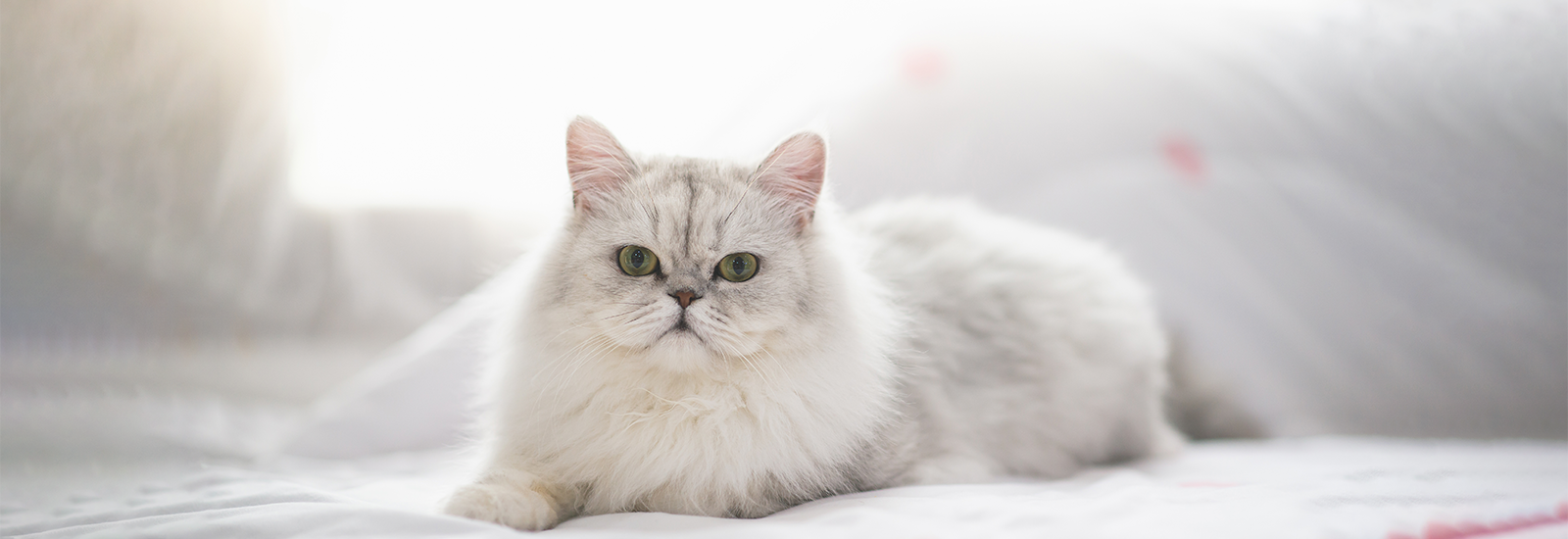Persian cat
No other breed of cat has such long fur as the Persian cat. This does, of course, require quite a lot of grooming, but anyone who likes cats with particularly long hair will be happy to put in the effort for these calm, affectionate pets.
Profile of the Persian cat
- Size large
- Weight female: approx. 5 kg, male: approx. 6.5 kg
- Origin Asia
- Build stocky, muscular
- Length of fur long. dense
- Colour of fur wide range of colours
- Grooming time-consuming
- Behaviour calm, likes to be cuddled
- Character affectionate, relaxed
Appearance and character of the Persian cat
There was a time when it was difficult to distinguish Persian cats from other long-haired breeds. However, in the 1970s there was a boom in America that led to far-reaching changes. The animals were bred with shorter legs and a less elongated body, which gave them a stocky appearance. But most importantly, breeders in America also favoured the idea of creating increasingly short noses and flatter faces. This resulted in the “peke-face” look, something that is definitely not to everyone’s taste and which, depending on the severity, can have negative implications for the cat’s health.
Thankfully, Persian breeding in Europe has been much more moderate than in the USA, however improvements would still be worthwhile. The breed standard does at least stipulate that the nose should not be excessively short or turned up and that the nostrils should be sufficiently open to ensure easy, unrestricted breathing.
The Persian cat does not have long legs, but it is a large breed of cat that can weigh up to 7.5 kilograms. Its lush coat makes it look even bigger. It is long, dense, fluffy and very soft. The fur comes in a wide range of colours: there are plain white, cream, red, purple, blue, chocolate and black Persian cats. There are also two- or three-coloured and “pointed” ones.
Persian cats not only look outwardly very laid-back, this is also reflected in their character. They are not temperamental and do not need constant activity. They like to take it easy and are very resistant to stress. Their top priority is finding cosy spots on the couch, in their cuddly caves, or on the windowsill. They are also fond of extensive stroking and cuddling sessions. However, not everyone is granted this honour. The Persian cat tends to be somewhat reserved towards strangers; a little patience is needed here.
Keeping and caring for a Persian cat
Persian cats are usually kept as strictly indoor cats, because if they are allowed outside. you can expect to find all kinds of debris in their long fur. Persian cats do not have a problem with being kept indoors, particularly because most of them do not know anything else. All they need is an interesting spot at the window and if possible, the opportunity to go out onto the balcony. Most of all, however, they love going through life with a fellow cat at their side. The two of them are able to pass the time together perfectly and it is not so bad if they occasionally have to stay at home alone for an extended period of time. Here, you should make sure that they have plenty of additional things to keep them occupied. They do not necessarily have to have a cat tree that reaches right up to the ceiling, but they should at least have a scratching board, a cuddly cave, places that they can look down from, and lots of toys. In addition, always remember to plan plenty of time with your little companions, because they usually want a lot of contact with their humans.
If you are looking for a pet that is very independent and requires only minimal care, it is best to avoid this breed of cat. There are few other breeds that require as much grooming as the Persian cat. They need to be combed daily; otherwise there is an increased risk of their fur becoming matted. Dealing with this will become increasingly difficult and combing and de-matting may eventually no longer be possible. Here, the cat may have to be fully shaved. To avoid this, kittens should be familiarised with combing from an early age so that it becomes a natural part of their daily ritual. During moulting, some cat owners even reach for a brush and comb twice a day. This is not only for grooming but also to prevent the cat from swallowing too much hair when it cleans itself.
Nutrition
Whether it’s a kitten, an adult cat or a senior – the food for a Persian cat should always be of high quality and tailored to its age. Cats are carnivores by nature, so cat food should always contain a high proportion of meaty ingredients. Sugar, flavour enhancers and artificial colourings and preservatives do not belong in the food.
Persian cat: health
In the breeding of Persian cats, there is an American and an English variant. The traditional English method does not involve “flattening” of the cats’ faces. Although they too can suffer from hereditary diseases, they are not subject to the condition known as brachycephaly. This refers to the cats having flat faces and shortened skulls. As a result, they have short noses, which can cause breathing problems. It can also lead to misaligned teeth and problems with the eyes. The symptoms are constantly watery, clogged eyes. To ensure healthy cat breeding, only very mild levels of brachycephaly should be permitted, and by no means the more severe ones, which are regarded as torture breeding.
Apart from their own special problems, common hereditary diseases can also occur in Persian cats. One of these is polycystic kidney disease (PKD), which is inherited dominantly. Reputable breeders always test their cats for this disease and remove them from their breeding programme, because there is no cure.
Persian cats can also suffer from progressive retinal atrophy (PRA) and hypertrophic cardiomyopathy. This is the most common heart disease in cats.
History and breeding
The term Persian cat can obviously lead to the assumption that the breed originated in Persia. However, American studies conducted in 2014 were unable to provide any evidence of this. Instead, genetic similarities were found with long-haired Russian domestic cats. These are currently considered to be the true ancestors of the Persian cat. They did, however, look very different back then and had more of a resemblance to Angora cats.
For reasons that are no longer clear today, the term “Persian cat” became established at the beginning of the 20th century. It was, perhaps, assumed that the breed originated in Asia Minor. As is often the case, the English in particular were involved in the breeding of this type of cat. Although they also occasionally made adjustments to the breed standard, there were no significant deviations until the 1970s, when a veritable craze for Persian cats swept through the USA. The breeders focussed on increasingly flat faces, shorter noses, longer fur and a stockier body. This resulted in numerous health problems that the breed is still struggling with today.
In 1949, the Persian cat was recognised by the European governing body, FIFe. The breed standard stipulates that there must be a well-defined nose stop between the eyes, which must be neither above the upper nor below the lower eyelid. However, not all breeders observe this rule. Some do not favour this type of breeding and instead focus on the old English variant with a normal nose. If you are interested, simply search online for “Persian cat with nose”.
You may also like this
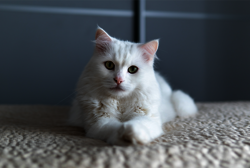
Turkish Angora
The beautiful long hair is the trademark of this breed

Türkish Van
Their light coat and colored tail are the trademark of the breed
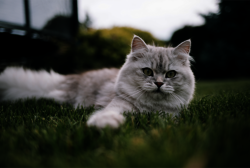
British Longhair
The long-haired variant of the British Shorthair
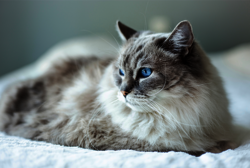
Ragdoll
The Ragdoll is a gentle breed of cat
